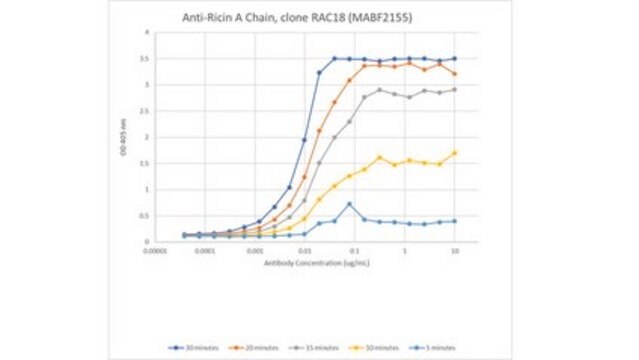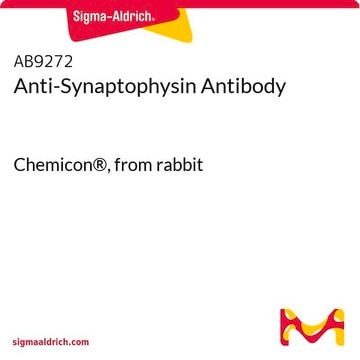MABN1193
Anti-Synaptophysin Antibody, clone 10F6.1
clone 10F6.1, from mouse
Synonym(s):
Major synaptic vesicle protein p38
Sign Into View Organizational & Contract Pricing
Select a Size
All Photos(2)
Select a Size
Change View
About This Item
UNSPSC Code:
12352203
eCl@ss:
32160702
NACRES:
NA.41
Recommended Products
biological source
mouse
Quality Level
antibody form
purified immunoglobulin
antibody product type
primary antibodies
clone
10F6.1, monoclonal
species reactivity
mouse, rat, human
technique(s)
immunohistochemistry: suitable (paraffin)
western blot: suitable
isotype
IgG2aκ
NCBI accession no.
UniProt accession no.
General description
Synaptophysin (UniProt: P07825; also known as Major synaptic vesicle protein p38) is encoded by the Syp gene (Gene ID: 24804) in rat. Synaptophysin belongs to the synaptophysin/synaptobrevin family of proteins. It is one of the major glycoproteins present in presynaptic vesicles and in various neuroendocrine cells of both neuronal and epithelial phenotype. Its structure consists of a hexameric protein of four transmembrane spans with a short cytoplasmic amino and a long carboxy-terminal tail. Both amino- and carboxy-terminals are exposed on the cytoplasmic surface of the synaptic vesicle membrane. C-terminal domain of Snaptophysin is selectively required for the endocytosis during, but not after, cessation of sustained synaptic transmission. Synaptophysin is involved in organizing membrane components may regulate endocytosis to ensure vesicle availability following sustained neuronal activity. It is also involved in the regulation of short-term and long-term synaptic plasticity. Syp / neurons display functional deficiencies and slower recovery of the recycling synaptic vesicle pool. (Ref.: Kwon, SE and Chapman, ER (2011). Neuron. 70(5): 847 854).
Specificity
Clone 10F6.1 detects synaptophysin in rat, human, and mouse brain. It targets a sequence within amino acids 222-307 in rat synaptophysin.
Immunogen
GST/His-tagged recombinant fragment corrsponding to 86 amino acids from the C-terminal region of rat synaptophysin.
Application
Anti-Synaptophysin Antibody, clone 10F6.1, Cat. No. MABN1193, is a highly specific monoclonal antibody that targets Synaptophysin and has been tested in Immunohistochemistry (Paraffin) and Western Blotting.
Immunohistochemistry Analysis: A 1:1,000 dilution from a representative lot detected Synaptophysin in human cerebellum, human cerebral cortex, and human pancreatic tissues.
Research Category
Neuroscience
Neuroscience
Quality
Evaluated by Western Blotting in rat brain tissue lysate.
Western Blotting Analysis: A 1:50,000 dilution of this antibody detected Synaptophysin in 10 µg of rat brain tissue lysate.
Western Blotting Analysis: A 1:50,000 dilution of this antibody detected Synaptophysin in 10 µg of rat brain tissue lysate.
Target description
~40 kDa observed; 33.31 kDa calculated. Glycosylated form displays higher molecular weight (~38 kDa). Uncharacterized bands may be observed in some lysate(s).
Linkage
Replaces: MAB368
Physical form
Format: Purified
Protein G purified
Purified monoclonal antibody IgG2a in buffer containing 0.1 M Tris-Glycine (pH 7.4), 150 mM NaCl with 0.05% sodium azide.
Storage and Stability
Stable for 1 year at 2-8°C from date of receipt.
Other Notes
Concentration: Please refer to lot specific datasheet.
Disclaimer
Unless otherwise stated in our catalog or other company documentation accompanying the product(s), our products are intended for research use only and are not to be used for any other purpose, which includes but is not limited to, unauthorized commercial uses, in vitro diagnostic uses, ex vivo or in vivo therapeutic uses or any type of consumption or application to humans or animals.
Not finding the right product?
Try our Product Selector Tool.
recommended
Product No.
Description
Pricing
Storage Class
12 - Non Combustible Liquids
wgk_germany
WGK 1
Certificates of Analysis (COA)
Search for Certificates of Analysis (COA) by entering the products Lot/Batch Number. Lot and Batch Numbers can be found on a product’s label following the words ‘Lot’ or ‘Batch’.
Already Own This Product?
Find documentation for the products that you have recently purchased in the Document Library.
Qingyong Li et al.
Journal of neuroinflammation, 19(1), 145-145 (2022-06-15)
Exposure to sunlight may decrease the risk of developing Alzheimer's disease (AD), and visible and near infrared light have been proposed as a possible therapeutic strategy for AD. Here, we investigated the effects of the visible, near infrared and far
Fang Liu et al.
Cells, 11(24) (2022-12-24)
Multiple Sclerosis (MS) is a highly disabling neurological disease characterized by inflammation, neuronal damage, and demyelination. Vision impairment is one of the major clinical features of MS. Previous studies from our lab have shown that MDL 72527, a pharmacological inhibitor
Deletion of Arginase 2 Ameliorates Retinal Neurodegeneration in a Mouse Model of Multiple Sclerosis.
Chithra D Palani et al.
Molecular neurobiology, 56(12), 8589-8602 (2019-07-08)
Optic neuritis is a major clinical feature of multiple sclerosis (MS) and can lead to temporary or permanent vision loss. Previous studies from our laboratory have demonstrated the critical involvement of arginase 2 (A2) in retinal neurodegeneration in models of
Our team of scientists has experience in all areas of research including Life Science, Material Science, Chemical Synthesis, Chromatography, Analytical and many others.
Contact Technical Service








